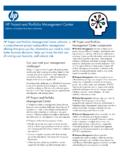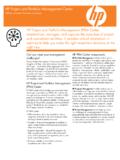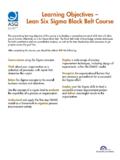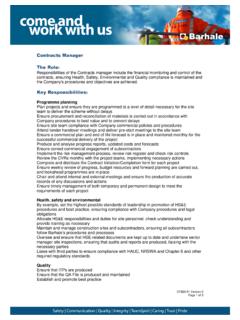Transcription of 21 Ways to Excel at Project Management
1 21 21 21 21 Ways tWays tWays tWays to Excel at o Excel at o Excel at o Excel at Project ManagementProject ManagementProject ManagementProject Management If we keep doing what we re doing, we re going to keep getting what we re getting. Stephen R. Covey Duncan Haughey 21 Ways to Excel at Project Management 1 Project Smart About About About About This BookThis BookThis BookThis Book We are all engaged on a journey to achieve excellence in our industries, whether it is automotive, consumer goods, petrochemical or construction. Effective Project and Programme Management is a key enabler of this change process. We need projects that deliver the agreed business benefits on-time and within budget, time after time.
2 This is best achieved by keeping a clear focus on the business objectives of the Project and through applying commonly accepted tools, techniques and methods. The aim must be to provide our Project Managers with simple processes that can be rigorously and consistently applied to produce predictable results. This book has been designed with that aim in mind and sets out an approach that can be adopted for managing all kinds of projects. Duncan Haughey 21 Ways to Excel at Project Management 2 Project Smart Table of contentsTable of contentsTable of contentsTable of contents 21 Ways to Excel at Project Management About This Book .. 1 Introduction .. 5 The Stages of a Project .
3 7 1. Definition .. 7 2. Initiation .. 7 3. Planning .. 8 4. Execution .. 8 5. Monitoring & Control .. 8 6. Closure .. 8 Sponsorship & Leadership .. 9 Question 1: Do you have sufficient business sponsorship and leadership? .. 9 Common Mistakes .. 10 Notes .. 10 Defining the Business Objectives & Benefits .. 11 Question 2: Have you defined and understood the business objectives and benefits? .. 11 Common Mistakes .. 11 Notes .. 11 Planning the Project .. 13 Question 3: Have you developed a detailed Project plan? .. 13 Common Mistakes .. 13 Ensuring the Project is a Manageable Size .. 15 Question 4: Is your Project a manageable size? .. 15 Common Mistakes .. 15 Defining the Budget.
4 17 Question 5: Have you defined a detailed Project budget? .. 17 Common Mistakes .. 18 Managing the Risks .. 19 Question 6: Are you managing the Project risks? .. 19 Common Mistakes .. 20 Notes .. 20 Getting the Right Project Manager .. 21 21 Ways to Excel at Project Management 3 Project Smart Question 7: Have you appointed an experienced Project manager? .. 21 Common Mistakes .. 22 Getting Customer Representation .. 23 Question 8: Do you have experienced and effective user representation? .. 23 Common Mistakes .. 23 Notes .. 23 Defining Roles & Responsibilities .. 24 Question 9: Have you clearly defined the Project roles and responsibilities? .. 24 Common Mistakes.
5 25 Notes .. 25 Getting the Right Resources .. 26 Question 10: Do you have enough experienced resources? .. 26 Common Mistakes .. 26 Monitoring & Reporting Progress .. 28 Question 11: Are you monitoring progress regularly? .. 28 Common Mistakes .. 28 Warning Signs! .. 29 Communicating Progress .. 30 Question 12: Are you distributing regular progress reports? 30 Common Mistakes .. 31 Consultation & Leadership .. 32 Question 13: Are you achieving the right balance of consultation and leadership? .. 32 Common Mistakes .. 32 Notes .. 32 Getting Realistic User Requirements .. 33 Question 14: Are the user requirements realistic? .. 33 Common Mistakes .. 34 Defining Your Approach.
6 35 Question 15: Have you based your development on a prototyping iterative approach? .. 35 Common Mistakes .. 36 Conducting Structured Testing .. 37 Question 16: Have you conducted structured testing? .. 37 21 Ways to Excel at Project Management 4 Project Smart Common Mistakes .. 38 Creating an Implementation Plan .. 39 Question 17: Do you have a comprehensive implementation plan? .. 39 Common Mistakes .. 40 Conducting a Post Implementation Review .. 41 Question 18: Have you conducted a post implementation review? .. 41 Common Mistakes .. 42 Realising the Benefits .. 43 Question 19: Will the deliverables and benefits of your Project survive? .. 43 Common Mistakes.
7 44 Learning the Lessons .. 45 Question 20: Have you looked at the lessons learned from your Project ? .. 45 Common Mistakes .. 45 Celebrating Success .. 47 Question 21: Have you celebrated the success of your Project ? .. 47 Checklist .. 48 21 Ways to Excel at Project Management 5 Project Smart IntroductionIntroductionIntroductionIntr oduction Project Management is the dynamic process that utilises the appropriate resources of the organisation in a controlled and structured manner, to achieve some clearly defined objectives identified as strategic needs. It is always conducted within a defined set of constraints. 1 Learn more with this book, written in a question and answer style, containing 21 pieces of valuable advice for making your projects a success.
8 Project Management in the modern sense began in the 1950s, although it has its roots much further back in the latter years of the 19th century. The need for Project Management was driven by businesses that realised the benefits of organising work around projects, and the critical need to communicate and coordinate work across departments and professions. One of the forefathers of Project Management is still a familiar name today, Henry Gantt (1861-1919) creator of the Gantt chart. Still in use, one hundred-years from their birth, Gantt charts are one of the Project managers' most valuable tools. In the mid-20th century PERT charts emerged, complex network diagrams that show the critical path of a Project .
9 These tools and techniques spread quickly as businesses looked for new ways to manage large and complex activities, evolving into Project Management as we know it today. It is now sixty years since the birth of Project Management and much of the early work has been collected and put together into formal methodologies. Although many different methodologies exist, they all work with the same basic principles and good 21 Ways to Excel at Project Management 6 Project Smart practice. So now you may expect we are expert when it comes to running projects, but sixty years on and Project failures are still with us, and according to some observers rising in number. Siemens made headlines in the UK when Government systems for new passports were hit by terrible delays.
10 ICL also failed with its system to automate benefit payments; the Project was axed with 460m of taxpayers' money wasted. In 1992, the London Ambulance Service launched a new computer system that slowed its response times to emergency calls. More recently the 21bn Eurofighter Project has experienced problems caused by 'delays in bringing the detailed design to full maturity in some areas', which prevented flight-tests from starting on time. Projects go wrong for the same reasons all the time. There are no new sins. We can look at a Project in its first two months and know if it will be a success or not. Many organisations are failing to heed painful lessons learned from past projects.





